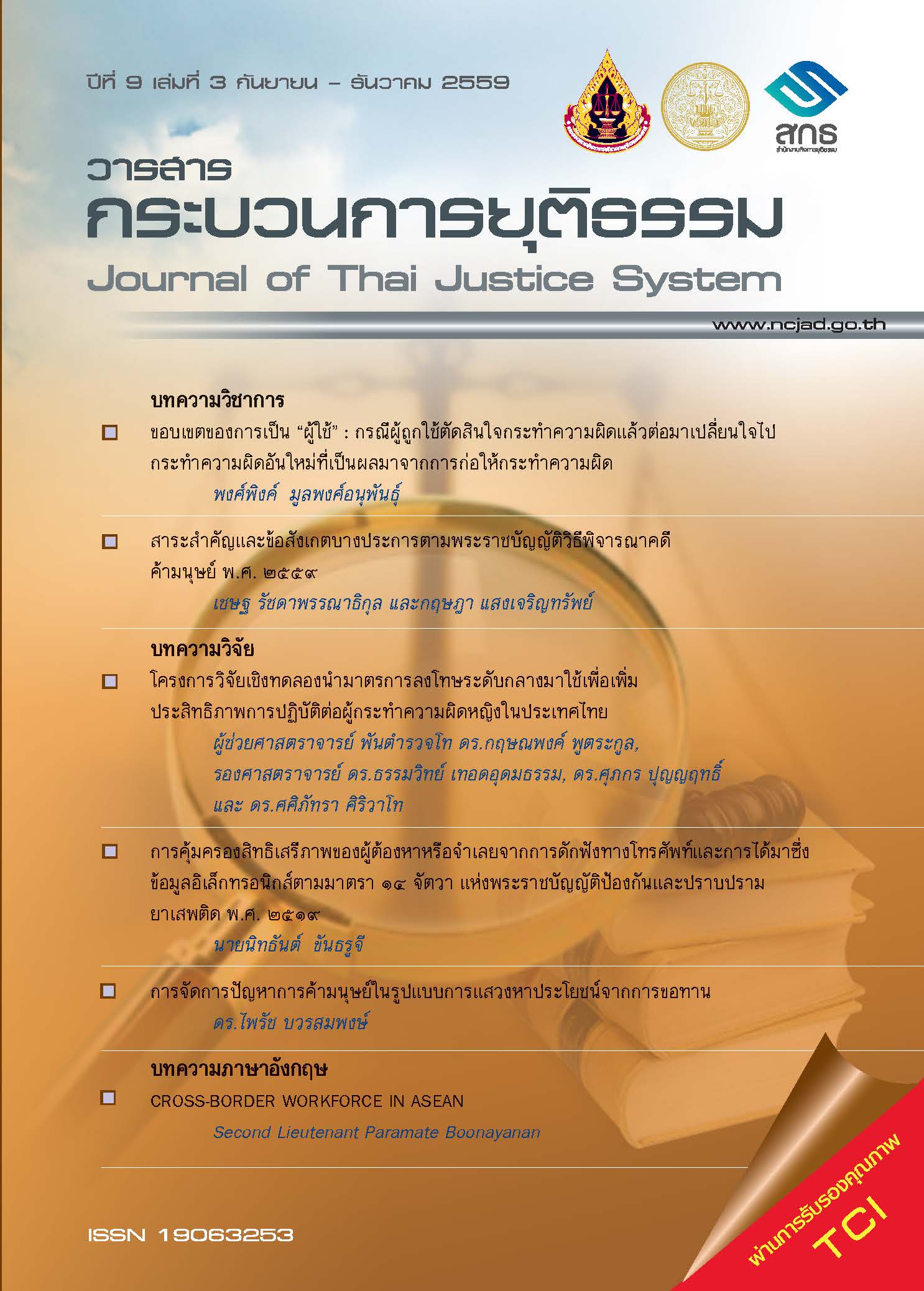การจัดการปัญหาการค้ามนุษย์ในรูปแบบการแสวงหาประโยชน์จากการขอทาน
Main Article Content
บทคัดย่อ
การวิจัยเรื่อง “ปัญหาการค้ามนุษย์ในรูปแบบการแสวงหาประโยชน์จากการขอทาน” มีวัตถุประสงค์เพื่อศึกษาถึงที่มาและสถานการณ์ของปัญหาขอทานในสังคมไทย มุมมองเกี่ยวกับขอทานและการขอทาน รวมถึงการวิเคราะห์มาตรการจัดการปัญหาขอทาน เพื่อนำไปสู่การจัดทำข้อเสนอแนะต่อการจัดการปัญหาการค้ามนุษย์ในรูปแบบบังคับขอทาน
การวิจัยนี้ใช้รูปแบบการวิจัยเชิงคุณภาพ โดยใช้วิธีการเก็บข้อมูลแบบหลายวิธีการไม่ว่าจะเป็นการวิจัยเชิงเอกสาร การสัมภาษณ์ผู้ให้ข้อมูลหลัก การอภิปรายกลุ่ม การลงพื้นที่ภาคสนามเพื่อทำความเข้าใจเกี่ยวกับปัญหาการค้ามนุษย์ในรูปแบบการแสวงหาประโยชน์จากการขอทาน และใช้การวิเคราะห์ข้อมูลเชิงเนื้อหาและนำเสนอข้อมูลด้วยวิธีการพรรณนา
ผลการวิจัยพบว่า ปัญหาการค้ามนุษย์ในรูปแบบการแสวงหาประโยชน์จากการขอทานเป็นปัญหาที่มีความสลับซับซ้อนและเชื่อมโยงกับค่านิยมของสังคมว่าด้วย “การให้” ทำให้ปรากฏการณ์ขอทานที่เกิดขึ้นมีหลายลักษณะทั้งที่มาจากปัญหาความยากจนอันเป็นแรงผลักดันให้ต้องมาขอทาน หรือแรงดึงดูดจากการได้เงินมาโดยง่ายทำให้เกิดกลุ่มอาชีพขอทาน หรือกลุ่มขบวนการเร่ขอทาน หรือกรณีการเข้ามาเป็นขอทานของชาวต่างชาติที่หลั่งไหลมาจากประเทศเพื่อนบ้าน
ในขณะที่มุมมองของสังคมเกี่ยวกับปัญหาขอทานยังคงมองว่า “การขอทานเป็นเรื่องปกติ การให้เป็นเรื่องของความดีงาม” ทำให้ปัญหาขอทานยังคงถูกผลิตซ้ำซึ่งปัญหาและสร้างผลกระทบในวงกว้างเนื่องจากปัญหาขอทานมีความเกี่ยวข้องกับขบวนการค้ามนุษย์และกระทำความผิดทางอาญาในลักษณะองค์กรอาชญากรรมข้ามชาติ หากแต่วิธีในการแก้ไขปัญหากลับมุ่งไปที่การจัดระเบียบอันเป็นมาตรการที่มุ่งควบคุมและนำบุคคลที่มาขอทานเข้ารับการบำบัดฟื้นฟู ฝึกอาชีพในสถานสงเคราะห์ ประกอบกับข้อจำกัดในการคัดกรองและจำแนกการเป็นผู้เสียหายจากการค้ามนุษย์เพื่อเข้าสู่กระบวนการคุ้มครองดูแล จึงทำให้ไม่สามารถดำเนินการป้องกันและปราบปรามหรือดำเนินคดีกับขบวนการค้ามนุษย์ได้อย่างมีประสิทธิภาพ
ข้อเสนอแนะจากการวิจัยครั้งนี้คือ แนวทางการจัดการปัญหาการค้ามนุษย์ในรูปแบบการแสวงหาประโยชน์จากการขอทานจำเป็นต้องเริ่มจากกระบวนการค้นหาข้อเท็จจริงเพื่อจำแนก คัดกรองผู้เสียหายเข้าสู่กระบวนการคุ้มครอง การฟื้นฟู และการเตรียมความพร้อมผู้เสียหายในการให้ความร่วมมือในการปราบปราม ควบคู่ไปกับการกำหนดมาตรการคุ้มครองพยาน รวมถึงบุคคลในครอบครัว ซึ่งต้องทำงานภายใต้หลักสหวิชาชีพ รวมถึงการสร้างความเข้าใจและความตระหนักรู้ของสังคมเกี่ยวกับการให้ทานที่ถูกต้องที่ไม่จำเป็นต้องกระทำผ่านการให้เงินขอทานเนื่องจากประเทศไทยมีระบบรัฐสวัสดิการที่ดูแลในทุกกลุ่มเป้าหมาย
Article Details
ต้นฉบับที่ได้รับการตีพิมพ์ในวารสาร เป็นลิขสิทธิ์ของวารสารกระบวนการยุติธรรม แต่ความคิดเห็นที่ปรากฏในเนื้อหาของบทความในวารสารกระบวนการยุติธรรม ถือเป็นความรับผิดชอบของผู้เขียนแต่เพียงผู้เดียว
เอกสารอ้างอิง
กรมประชาสงเคราะห์ กองสวัสดิการสงเคราะห์. (2538). สาเหตุ ปัญหา และความต้องการของคนเร่ร่อนขอทาน. รายงานการวิจัย.
ณรงค์ เพ็ชรประเสริฐ. (2546). ความลำบากในโลกมืด: กรณีศึกษาขอทานและวณิพกตาบอด. เอกสารงานวิจัยในโครงการพัฒนาระบบสวัสดิการสังคมสำหรับคนจนและคนด้อยโอกาสในสังคมไทย. กรุงเทพฯ: สำนักงานกองทุนสนับสนุนการวิจัย.
ทรงพล พันธุ์วิชาติกุล. (2547). ความผิดฐานค้ามนุษย์ตามอนุสัญญาสหประชาชาติเพื่อต่อต้านอาชญากรรมข้ามชาติที่จัดตั้งในลักษณะองค์กร ค.ศ.200 และผลกระทบหากประเทศไทยเข้าเป็นภาคี.วิทยานิพนธ์นิติศาสตร์มหาบัณฑิต จุฬาลงกรณ์มหาวิทยาลัย.
พระราชบัญญัติควบคุมขอทาน พ.ศ.2484
พัทฐกร ศาสนะสุพินธ์ ดุษฎี อายุวัฒน์และมณีมัย ทองอยู่. (2554). กระบวนการย้ายถิ่นข้ามชาติของผู้ย้ายถิ่นที่ตกเป็นเหยื่อการค้ามนุษย์. วารสารวิจัย มข : ปีที่ 1 ฉบับที่ 1 : เมษายน-มิถุนายน 2554 หน้า 95-110
ภิรมย์ เจริญผล. (2537). ทัศนคติของคนไร้ที่พึ่งต่อการฝึกอาชีพในสถานสงเคราะห์ชายและหญิงธัญญบุรี จังหวัดปทุมธานี. ภาคนิพนธ์พัฒนบริหารศาสตร์มหาบัณฑิต คณะพัฒนาสังคม สถาบันบัณฑิตพัฒนบริหารศาสตร์.
มูลนิธิกระจกเงาและศูนย์ข้อมูลคนหายเพื่อการต่อต้านการค้ามนุษย์. (2549). การศึกษาและสำรวจเส้นทางเด็กขอทานในพื้นที่แม่สาย จังหวัดเชียงราย – พื้นที่เชียงใหม่.ใน รายงานการศึกษาและสำรวจข้อมูลเส้นทางเด็กขอทานในพื้นที่ชานแดนและพื้นที่เศรษฐกิจ. หน้า 17-19
มูลนิธิกระจกเงาและศูนย์ข้อมูลคนหายเพื่อต่อต้านการค้ามนุษย์. (2548). “ขอทานเด็ก...เหยื่อบริสุทธิ์ในขบวนการค้ามนุษย์” ใน การศึกษากระบวนการของเด็กที่อยู่ในธุรกิจขอทานและกระบวนการจัดการปัญหาขอทานโดยองค์กรภาครัฐเพื่อหาแนวทางช่วยเหลือในประเทศไทย. หน้า 6
(ร่าง) พระราชบัญญัติควบคุมการขอทานพ.ศ. ...
ศศิธร ไชยประสิทธิ์. (2545). วิถีชีวิตและเงื่อนไขการดำรงชีวิตของคนจนในหมู่บ้านชนบทภาคเหนือ, เอกสารงานวิจัยในโครงการพัฒนาระบบสวัสดิการสังคมสำหรับคนจนและคนด้อยโอกาสในสังคมไทย. กรุงเทพฯ: สำนักงานกองทุนสนับสนุนการวิจัย., อัดสำเนา.
ศิบดี นพประเสริฐ. (2553). ความมั่นคงของมนุษย์: การค้ามนุษย์ในไทย. ในจุลสารความมั่นคงศึกษา ฉบับที่ 84. กรุงเทพฯ: สแควร์ปริ๊นซ์93 จำกัด.
ศุภชัย ศรีหล้า, 2534 อ้างถึงใน จุฑามณี สมบูรณ์สุทธิ์. (2547). หญิงชรา ความจน คนชายขอบ: ชีวิตริมฟุตบาทของหญิงชราขอทาน. วิทยานิพนธ์ศิลปศาสตรมหาบัณฑิต (สตรีศึกษา) สำนักบัณฑิตอาสาสมัคร มหาวิทยาธรรมศาสตร์.
สำนักบริการสวัสดิการสังคม, กรมพัฒนาสังคมและสวัสดิการ. (2557). ผลการประชุมเชิงปฏิบัติการ “ถอดบทเรียนการจัดระเบียบคนขอทาน” วันที่ 18 พฤศจิกายน 2557. มปท.
เสาวลักษณวรายุ. (2548). คนข้ามแดน: ชีวิตและชุมชนของขอทานเขมรในกรุงเทพมหานคร.วิทยานิพนธ์ศิลปศาสตรมหาบัณฑิต สาขาภูมิภาคศึกษา บัณฑิตวิทยา มหาวิทยาลัยเชียงใหม่.
อุ่นเรือน จุลกะเศียร. (2553). มาตรการทางกฎหมายในการป้องกันและปราบปรามการแสวงหาประโยชน์จากการขอทาน. วิทยานิพนธ์หลักสูตรนิติศาสตร์มหาบัณฑิต บัณฑิตวิทยาลัย มหาวิทยาลัยธุรกิจบัณฑิต.
ไพรัช บวรสมพงษ์ และคณะ. (2558). การจัดการปัญหาการค้ามนุษย์ในรูปแบบที่หลากหลาย. รายงานการวิจัย. กรุงเทพฯ: โรงพิมพ์ 50 express.
ข้อมูลออนไลน์
กระทรวงการพัฒนาสังคมและความมั่นคงของมนุษย์. (2558). พม. เชิญหน่วยงานที่เกี่ยวข้องประชุมซักซ้อมแผนการดำเนินงานการจัดระเบียบขอทานทั่วประเทศ. ออนไลน์. สืบค้นจาก http://www.m-society.go.th/ewt_news.php?nid=13242
ข่าวจริง สปริงนิวส์. (2556). ตร.เชียงใหม่จับหญิงพม่าเช่าเด็กมาขอทานมีรายได้วันละ 2,000 บาท. ออนไลน์. สืบค้นจาก: http://www.springnews.co.th/local/58784
โครงการรณรงค์ยุติธุรกิจเด็กขอทาน มูลนิธิกระจกเงา. (2556). รายงานสถานการณ์ปัญหาเด็กขอทานรอบปี 2556. ออนไลน์. สืบค้นจากhttp://www.notforsale.in.th/autopagev4/show_page.php?topic_id=1773&auto_id=7&TopicPk
ณิชชา บูรณสิงห์. (2557)ปัญหาขอทานเด็ก: ผลพวงของการพัฒนาที่ไม่สมดุล. ออนไลน์สืบค้นจากhttp://library2.parliament.go.th/giventake/content_nrcinf/nrc2557-article81.pdf
เดลินิวส์. (2558).จัดระเบียบขอทานครั้งที่ 3 ทั่วประเทศ 5 วัน. ออนไลน์. สืบค้นจาก http://www.dailynews.co.th/Content/politics/298238/จัดระเบียบขอทานครั้งที่+3+ทั่วประเทศ+5+วัน
เอกลักษณ์ หลุ่มชมแข. (2556). ตีตรามนุษย์…การหลงทางของนโยบายรัฐ. ออนไลน์ สืบค้นจาก http://www.thaipost.net/tabloid/170612/58324
สื่อออนไลน์
Child Beggars in New Delhi, India ออนไลน์. สืบค้นจาก https://www.youtube.com/watch?v=ejFI6JcVsLA&nohtml5=False
Gypsies begging in Poland 2011 ออนไลน์. สืบค้นจากhttps://www.youtube.com/watch?v=bZQE-X6SlsU
Gypsy beggar gangs in Sweden - part 1 ออนไลน์. สืบค้นจากhttps://www.youtube.com/watch?v=t5-nX_gYHPM
Gypsy beggar gangs in Sweden - part 2 ออนไลน์. สืบค้นจากhttps://www.youtube.com/watch?v=FOHHeaezDEo
Gypsy Christian Beggars from Romania Pretend to be Muslims ออนไลน์. สืบค้นจาก https://www.youtube.com/watch?v=Wx-o4MXEPGU
Richest Beggars in India ออนไลน์. สืบค้นจากhttps://www.youtube.com/watch?v=UHFmIoC86Ok
ภาษาอังกฤษ
Appadurai A. (1984).The Social Life of Things: Commodities in Cultural Perspective. Cambridge University Press.
Dociu M. and Dunarintu A. (2012).The Socio-Economic Impact of Urbanization. International Journal of Academic Research in Accounting, Finance and Management Sciences Volume 2, Special Issue 1 (2012), pp. 47-52
Duranton G. and Puga D. (2013).The Growth of Cities.Cited in Handbook of Economic Growth, Volume 2, edited by Steven N. Durlauf and Philippe Aghion, to be published by Elsevier.
Matunhu J. (2011).A critique of modernization and dependency theories in Africa: Critical assessment. African Journal of History and Culture Vol. 3(5), pp. 65-72, June 2011
OECD. (2015)The Metropolitan Century: Understanding Urbanisation and its Consequences.Online available at http://dx.doi.org/10.1787/9789264228733-en
Shareia B.F. (2015).Theories of Development.International Journal of Language and Linguistics Vol. 2, No. 1; March 2015.
Yeh S.H.K. (1989). Understanding Development: Modernization and Cultural Values in "ASIA AND THE PACIFIC Region” UNESCO.


